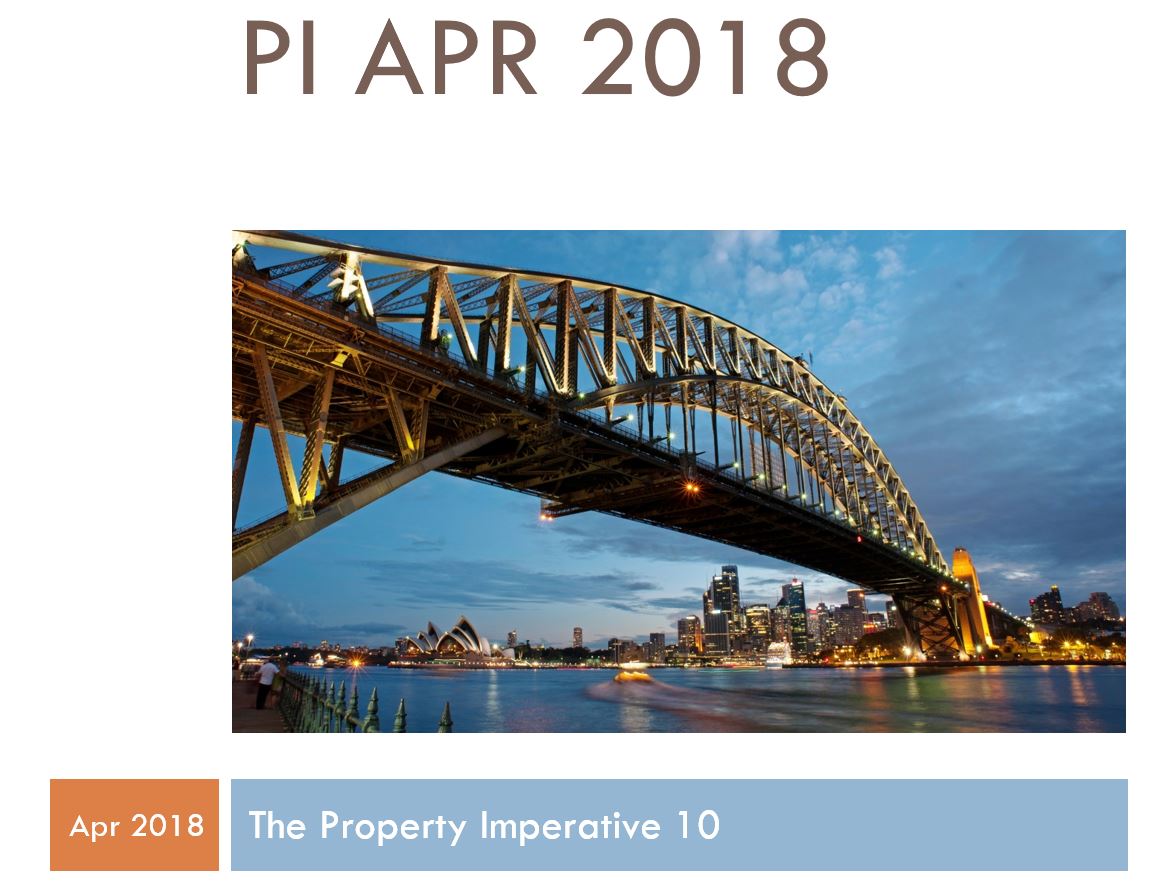The latest and updated edition of our flagship report “The Property Imperative” is now available on request with data to April 2018.
 This Property Imperative Report is a distillation of our research in the finance and property market, using data from our household surveys and other public data. We provide weekly updates via our blog – the Property Imperative Weekly, but twice a year publish this report. This is volume 10.
This Property Imperative Report is a distillation of our research in the finance and property market, using data from our household surveys and other public data. We provide weekly updates via our blog – the Property Imperative Weekly, but twice a year publish this report. This is volume 10.
Residential property, and the mortgage industry is currently under the microscope, as never before. The currently running Royal Commission has laid bare a range of worrying and significant issues, and recent reviews by the Productivity Commission and ACCC point to weaknesses in both the regulation of the banks and weak competition in the sector. We believe we are at a significant inflection point and the market risks are rising fast. Portfolio risks are being underestimated. Many recent studies appear to support this view. There are a number of concerning trends.
Around two thirds of all households have interests in residential property, and about half of these have mortgages. More households are excluded completely and are forced to rent, or live with family or friends.
We have formed the view that credit growth will slow significantly in the months ahead, as lending standards tighten. As a result, home prices will fall. We note that household incomes remain flat in real terms, the size of the average mortgage has grown significantly in the past few years, thanks to rising home prices (in some states), changed lending standards, and consumer appetite for debt. In fact, consumer debt has never been higher in Australia. Household finances are being severely impacted, and more recent changes in underwriting standards are making finance less available for many. But the risk is in those loans made in recent years under looser standards, including interest only loans.
Property Investors still make up a significant share of total borrowing, and experience around the world shows it is these households who are more fickle in a downturn. Many use interest only loans, which create risks downstream, and regulators have recently been applying pressure to lenders to curtail their growth. Already we are seeing a drop in investor loans, and a reduction in interest only loans. A significant proportion will be up for review within tighter lending rules. This may lift servicing costs, at very least and potentially cause some to sell.
We hold the view that home prices are set to ease in coming months, as already foreshadowed in Sydney. We think mortgage rates are more likely to rise than fall as we move on into 2019.
We will continue to track market developments in our Property Imperative weekly video blogs, and publish a further update in about six months’ time.
If you are seeking specific market data from our Core Market Model, reach out, and we will endeavour to assist.
Here is the table of contents.
1 EXECUTIVE SUMMARY 2 TABLE OF CONTENTS 3. OUR RESEARCH APPROACH 4. THE DFA SEGMENTATION MODEL 5 PROFILING THE PROPERTY MARKET 5.1 Current Property Prices 5.2 Property Transfer Volumes Are Down 5.3 Clearance Rates Are Easing 5.4 But Can We Believe the Auction Statistics Anyway? 6 MORTGAGE LENDING TRENDS 6.1 Total Housing Credit Is Up 6.2 ADI Lending Trends 6.3 Housing Finance Flows – Bye-Bye Property Investors 6.4 The Rise of the Bank of Mum and Dad 6.5 Lending Standards Are Tightening 6.6 How Low Will Borrowing Power Go? 6.7 The Portfolio Mix Is Changing 6.8 Funding Costs Are Higher 6.9 The Interest Only Loan Problem 7 HOUSEHOLD FINANCES AND RISKS 7.1 Households’ Demand for Property 7.2 Property Active and Inactive Households 7.3 Cross Segment Comparisons 7.4 Property Investors 7.5 How Many Properties Do Investors Have? 7.6 SMSF Property Investors 7.7 First Time Buyers. 7.8 Want to Buys 7.9 Up Traders and Down Traders 7.10 Household Financial Confidence Continues to Fall 7.11 Mortgage Stress Is Still Rising 7.12 But The RBA Is Unperturbed 7.13 Latest Household Debt Figures a Worry 8 THE CURRENT INQUIRIES 8.1 Productivity Commission 8.2 The ACCC Mortgage Pricing Review 8.3 The Royal Commission into Misconduct in Finance Services 8.4 Merge Financial Advice and Mortgage Brokering Regulation 9 AN ALTERNATIVE FINANCIAL NARRATIVE 9.1 Popping The Housing Affordability Myth 9.2 The Chicago Plan 10 FOUR SCENARIOS 11 FINAL OBSERVATIONS 12 ABOUT DFA 13 COPYRIGHT AND TERMS OF USE
Request the free report [85 pages] using the form below. You should get confirmation your message was sent immediately and you will receive an email with the report attached after a short delay.
Note this will NOT automatically send you our ongoing research updates, for that register here.
[contact-form to=’mnorth@digitalfinanceanalytics.com’ subject=’Request for The Property Imperative Report 10′][contact-field label=’Name’ type=’name’ required=’1’/][contact-field label=’Email’ type=’email’ required=’1’/][contact-field label=’Email Me The Report’ type=’radio’ options=’Yes Please’ required=’1′ /][contact-field label=’Comment If You Like’ type=’textarea’/][/contact-form]
